How to Read HVAC Gauges
The HVAC gauges and AC hoses are color coded
The manufacturers color coded the exteriors of the HVAC gauge (compound gauge and high pressure gauge) to distinguish between high pressure and low pressure gauges.
The low pressure gauge or compound gauge is color coded blue and the high pressure gauges are color coded red. Don’t confuse this with the manifold gauges assembly (body). It’s not color coded. The AC gauge hoses are color coded in blue, yellow, and red.
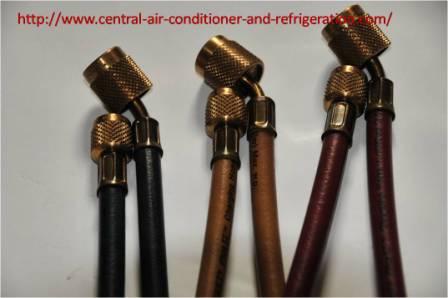
The AC gauge hoses port are not color coded, but the hose is color coded. The blue hoses are used to connect the manifold to the low pressure side (central air units suction line).
The color coded red mark the high pressure gauges and it’s connected to the air conditioner unit discharge valve or liquid line valves. Some manufacturers even color code the hand valves.
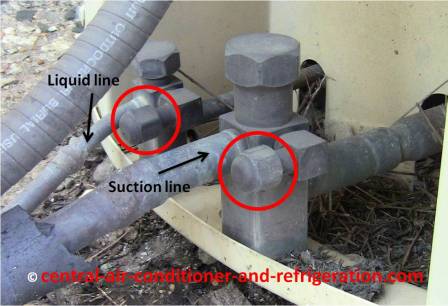
The manifold gauge uses flexible hoses with connector on both sides. These hoses are label with maximum pressure in PSI or bar. This mean that if someone used the wrong hoses with the wrong pressure it will burst.
The compound gauge – located in the left hand of HVAC gauges
The compound gauge is mounted on the left side of the air conditioning gauges. The compound gauges allow the HVAC technician to measure both pressure. The pressure above atmospheric pressure and vacuum pressure (blow atmospheric pressure).
Here is what compound gauge looks like:
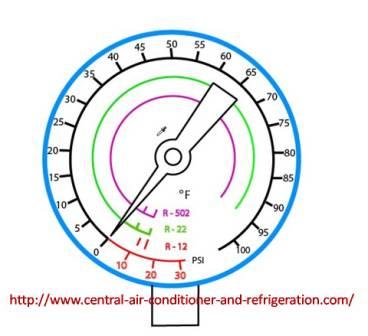
How to use compound gauge (low pressure gauge)
This compound
gauge is a R-22 gauge (There is a R410A, 134A compound gauge).
The
pressure scales are in black and in red number. The black numbers are above
atmospheric pressure, which range from zero to 150 pounds per square inch gauge
(psig). However, I couldn’t label all of it, so we only see zero to 100 psi in
the picture above.
The pressure below atmospheric pressure is in red number and it’s read in inches of mercury (in. Hg). The below atmospheric pressure is measure from zero to 30 in. Hg vacuum.
Here is the actual compound gauge:
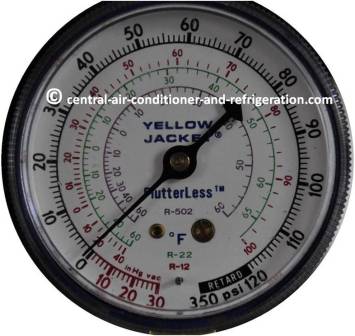
How to read air conditioning gauges
Air conditioner gauges are a pressure and temperature charts in a gauges. We’ll read it the same way we read a pressure and temperature chart.
When every HVAC technician looks at gauges, he or she either looking for pressure or temperature. Let say we have R -22 refrigerants and the temperature is 33°F, but we don’t know the pressure.
So, we used the pressure temperature chart or the manifold gauges to find out what is the pressure of R-22 refrigerant. That pressure would be 58.8 psi for R-22 refrigerant.
Here is sample of temperature and pressure chart in HVAC gauges:
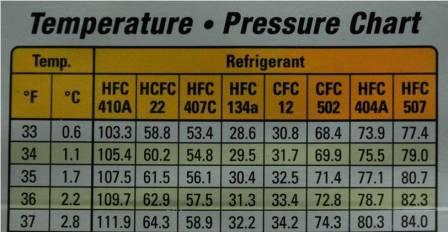
In the
temperature and pressure charts above, the Temperature scales are on the left
side and it’s in Fahrenheit or Celsius. On the right side we have the
difference types of AC refrigerant pressure.
Here is another example:
Ex. HCFC-22 refrigerant has a pressure of 62.9 psi, what is the temperature of R-22 refrigerant? The temperature would be 36 °F or 2.2 °C.
The most valuable information about the manifold gauge set is it could read a pressure and temperature of refrigerant in a close system. All HVAC gauges set read the same way. Except the pressure and temperature scales are different for R-134, R-410 refrigerant.
How to use HVAC manifold gauges videos
Make sure to press the Play button in the player controls to watch it. Enjoy!
Air conditioner gauges training Videos made by DrZarkloff
The high pressure gauge
The high pressure gauge is mounted on the right side of the manifold set. This air conditioning gauges set measure pressure above the atmosphere pressure. It reads from 0 to 500 psi and it scales is usually in 2-lb. or 5-lb. increments.
The high
pressure gauge is label the same way as the compound (low pressure gauge),
except we couldn’t read inches of mercury in high pressure gauge.
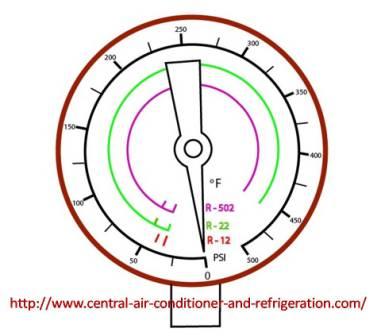
The black number is the PSI scale and the inner number is the refrigerant temperature of R-502, R-22 and R-12.
This is the actual high pressure gauges:
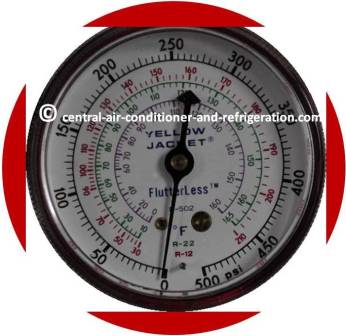
Types of air conditioning gauges
In HVAC field, we don’t have single set of HVAC gauges that work on every refrigerant. It saves us money and time if we have it. But, we don’t.
The reason we don’t have single HVAC manifold gauge is because of the refrigerant property. Each air conditioner Freon has a difference pressure, chemical compound, and boil points. However, that isn’t the main factor. It’s the refrigerant pressure and it temperatures scales.
Here is air conditioning manifold gauge we carry:
- R410A Manifold gauge set
- R22 Manifold gauge set
- R134a manifold gauge set
This means that we can’t use R - 22 gauges manifold to read an R - 410A refrigerant. It would damage the R- 22 gauge set due to high pressure of R 410 refrigerant.
Return to central air conditioner and refrigeration